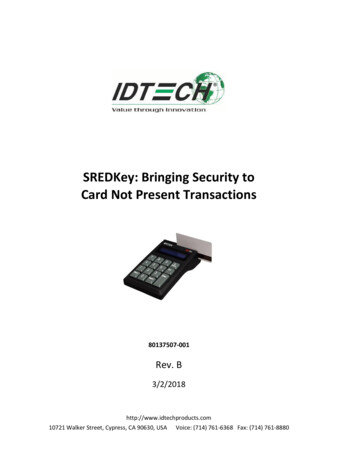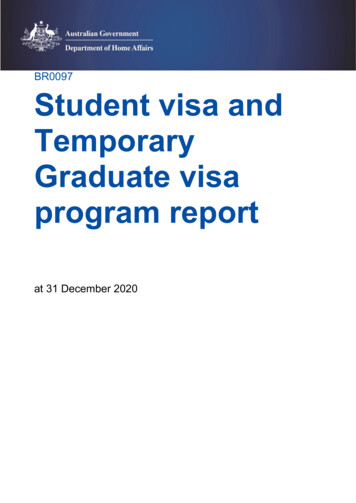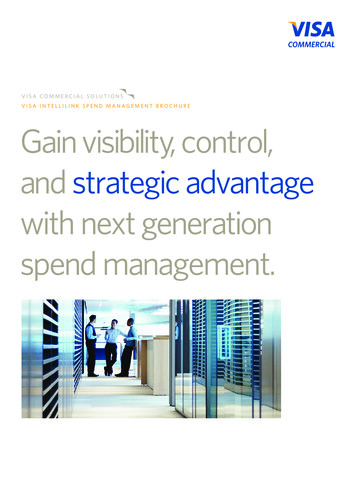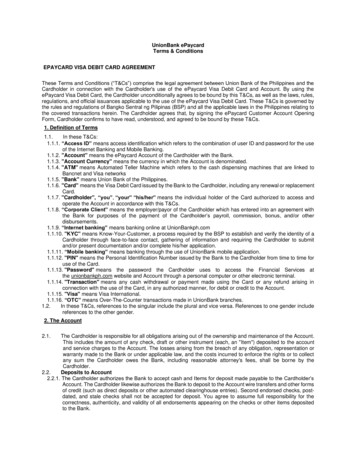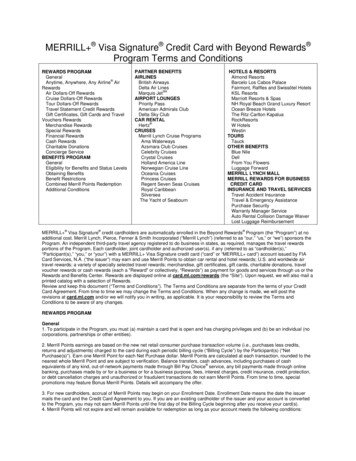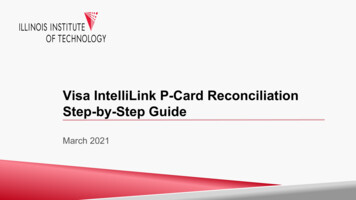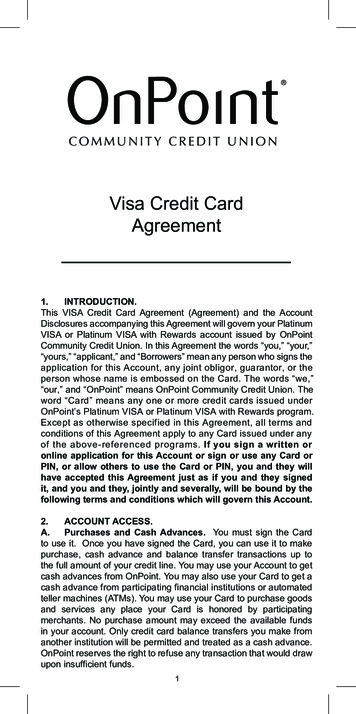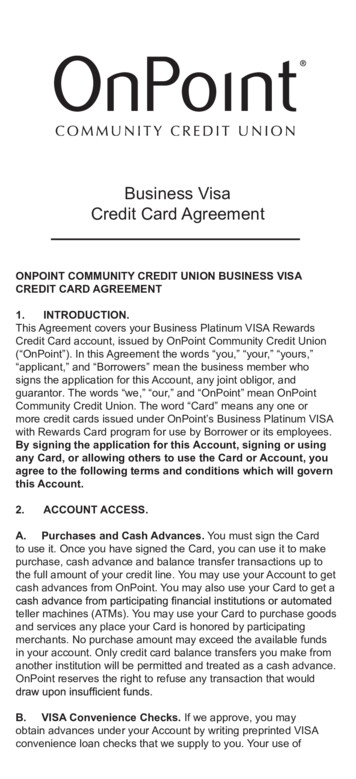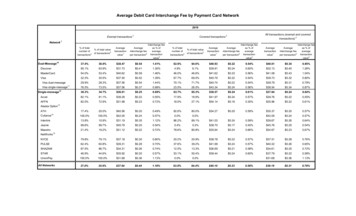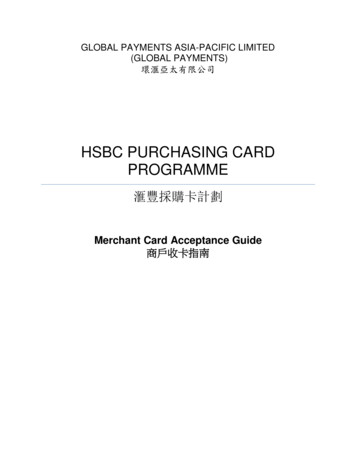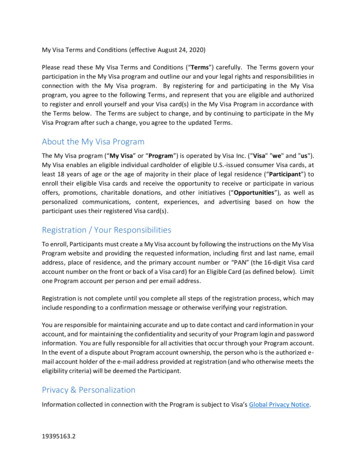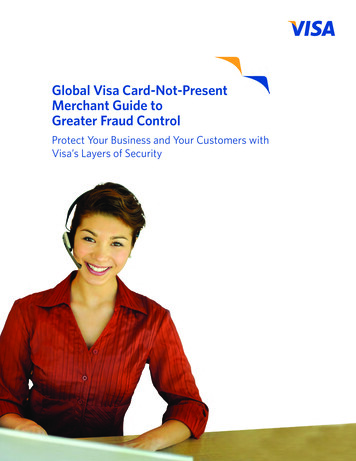
Transcription
Global Visa Card-Not-PresentMerchant Guide toGreater Fraud ControlProtect Your Business and Your Customers withVisa’s Layers of Security
Millions of Visa cardholders worldwide make one or morepurchases every day online, over the phone, or through themail—where the Visa card is not present.For Visa merchants who operate in the card-not-present environment, there are a large number of opportunities to enhancecustomer relationships, attract new customers, and increase sales revenue. There are, however, some additional fraud riskchallenges. According to the 12th annual Online Fraud Report by CyberSource1, U.S. merchants lost 2.7 billion to online fraud in2010, and over half of those surveyed indicated that fraud is getting “cleaner.” In other words, it’s getting harder to detect fraud,because fraudsters are becoming more sophisticated at looking like legitimate customers.Thieves are primarily interested in two things: stealing your sensitive payment data to re-sell on the black market, and/or using thatpayment data to steal goods and services from you. Hackers are constantly testing your systems to identify and exploit points ofweakness in your security, with increasing success. In 2010, there was a 33% increase in the number of data breaches reported byorganizations, according to the Identity Theft Resource Center.2Understanding the Risks with Card-Not-Present TransactionsIn order to help thwart these breaches, the Payment Card Industry (PCI) Data Security Standard (DSS) is a framework that providesenhanced security around merchants’ cardholder data. Consisting of twelve requirements, PCI DSS outlines the steps to take toprotect sensitive payment information. By demonstrating that you are PCI DSS-compliant, customers can be more confident buyingfrom you, assured that their cardholder data is secure.However, not all merchant’s security systems are foolproof. And if payment data is stolen, fraudsters or fraudster-controlled botnets(a network of compromised computers being used for malicious purposes) can attempt to steal as much as they can from you, usinglegitimate payment data. Often, the lag time it takes for you to detect the fraud results in customer chargebacks, loss of inventory,and ultimately, a hit to your bottom line. Regardless of the size of your business, you are a potential target if you’re conductingbusiness online, over the phone, or through the mail. That’s why it’s critical to take a multi-layered approach to fighting fraud andstrengthening security.Follow a Two-Step Fraud Detection SystemA robust fraud detection system consists of two stages: an automated evaluation followed by a manual investigation process. Theintent is to make as many systematic decisions as possible in order to lower your overhead costs and ensure the optimal customerexperience. Only those highly suspicious orders should be sidelined for a deeper level of review by an investigator.The first step, automated order screening, should leverage your own data, third-party fraud prevention tools (such as IP Geolocation,device fingerprinting, fraud-scoring models, velocity checks, and more), as well as a variety of services3 made available by Visa.These include Verified by Visa (VbV), Card Verification Value 2 (CVV2), and Address Verification Service (AVS).Second step, orders that do not pass the first step should then be sent to your order review team for further scrutiny. Thus, it’scritical that they are armed with the verification tools necessary to validate questionable orders, as well as a case managementsystem to keep track of the orders in queue. The verification tools and the case management system enable the reviewers to processmore orders more effectively and efficiently.Ensure that your fraud management process is optimized, develop key metrics to track and analyze over a set period of time. Inparticular, it is extremely helpful to feed fraud chargebacks and credits back into your fraud screening process, so that you canidentify fraud patterns and adjust your processes accordingly. Reporting around your order review team can also help to identify howefficiently your order review team performs, how accurate they are in detecting fraud, and where overall operations can improve.Select the Right ToolsComprehensive fraud prevention comes with having a complete fraud management process in place at your business. Start byusing your own data, and enhance your fraud intelligence with the right combination of fraud prevention and detection tools andcontrols supplied by third parties or Visa. If required, third-party fraud detection solutions (such as those offered by CyberSourceRisk Management Solutions) can provide deep fraud management expertise, as well as access to other fraud prevention tools.By supplementing the services provided by Visa with additional outside support, you can strengthen your defenses againstsophisticated fraudsters looking for an easy mark.123CyberSource is a wholly-owned subsidiary of Visa.662 in 2010 v. 498 reported in 2009; www.idtheftcenter.orgService availability varies by region. To learn more about the tools and business practices covered in this document, consult with your merchant bank. Theinformation contained in this document is intended only as a reference for merchants and is not a definitive set of instructions.
What Is A Layered Security Approach forCard-Not-Present Merchants?Visa fraud prevention tools are designed to complement eachother and work together as multiple services that can help youbetter combat fraud. Address Verification Service (AVS) verifies the creditcard billing address of the customer who is paying with aVisa card. The merchant includes an AVS request with thetransaction authorization and receives a result code (separatefrom the authorization response code) that indicates whetherthe address given by the cardholder matches the address inthe issuer’s file. A partial or no-match response may indicatean elevated fraud risk. Card Verification Value 2 (CVV2) is a three-digit code thatis printed on the signature panel of all Visa cards. Telephoneorder and Internet merchants use CVV2 to verify that thecustomer has a legitimate Visa card in hand at the time ofthe order. The merchant asks the customer for the three-digitcode and sends it to the issuer as part of the authorizationrequest. Again, the response can be used to make a riskevaluation. Verified by Visa (VbV) offers an extra level of security foronline transaction authentication. It is an innovative servicethat verifies cardholder identity in real-time so customerscan shop more confidently. Also, Internet merchants canaccept Visa cards with peace of mind while authenticating acardholder’s identity at the time of purchase. The Payment Card Industry (PCI) Data Security Standard(DSS) is intended to help protect Visa cardholder data—wherever it resides— ensuring that customers, merchants,and service providers maintain the highest informationsecurity standard. As mandated by Visa, all issuers, merchantbanks, agents, merchants, and service providers that store,process, or transmit cardholder data are required to complywith PCI DSS. This helps to protect not only your own data,but that of your fellow merchants as well. Decision Manager (DM) and Managed Risk Services byCyberSource enable mid-size to large companies detectfraud more accurately, review more efficiently, and improvecontrol over fraud management practices. Authorize.Net Advanced Fraud Detection SuiteTM (AFDS) isa set of customizable, rules-based filters and tools that helpsmall businesses identify, manage, and prevent suspiciousand potentially costly fraudulent transactions. Authorize.NetAFDS is a value-added service of the Authorize.Net PaymentGateway.The Right Combination of Tools at the Right TimeThe chart below highlights Visa’s layers of security by businesstype.VISA CNP FRAUD PREVENTIONTOOLSCard-Not-Present Fraud DetectionInternetTo supplement the effective use of your own data, Visa’s fraudprevention tools, and third party data feeds/services, vendorfraud detection solution providers such as CyberSource offera combination of leading technology and innovative tools fordetection and prevention of fraud within the various card-notpresent channels. These solutions are designed to help youprotect your customers and brand by reducing fraud losses andmaking the Internet and other sales channels safer to conductbusiness. To obtain a list of third party fraud prevention solutionproviders, contact your merchant VbVCVV2AVSPCIDSSDM/AFDS444444444444 CyberSource Risk Management Solutions provide frauddetection for organizations of all sizes.2 Global Visa Card-Not-Present Merchant Guide to Greater Fraud Control 2011 Visa. All Rights Reserved.
Fraud Prevention for Card-Not-Present Merchants:Start-to-FinishMail order/telephone order and Internet merchants must verify—to the greatest extent possible—the cardholder’s identity and thevalidity of the transaction. Basic fraud control actions include the tests listed below. Keep in mind, none of these tools should beused exclusively to determine the validity of the customer or to accept or reject an order. They should be used as indicators of risk,and in combination with other fraud detectors. If participating in the CVV2 service, obtain this three-digit code from the cardholder. The purpose of CVV2 in a card-notpresent transaction is to attempt to verify that the person placing the order has the actual card in his or her possession.Requesting the card verification number during a card-not-present purchase can add a measure of security to the transaction. Where available, verify the cardholder’s billing address via the AVS. AVS compares numeric address data with informationon file from the cardholder’s card issuing bank. AVS return codes are generally available for U.S. cardholders and for a limitednumber of cardholders in Canada. For Internet transactions, use VbV to authenticate the cardholder’s identity at the time of purchase. Do not submit anauthorization request for VbV transactions that fail authentication. If the customer’s telephone number is supplied as part of the transaction, use area code or reverse lookup tables to verify thelegitimacy and location of the phone number (these are widely available). Similarly, postal address validation services can beused to distinguish legitimate addresses from bogus ones. Leverage your own customer history data effectively. If you have had a fraud event associated with a customer, the details ofthat transaction should be added to internal “negative lists.” Any subsequent order that shares the same characteristics shouldbe considered suspicious.Many of these tests can be conducted automatically, depending on the flexibility of your technical infrastructure or your abilityto connect with fraud prevention service providers. Instead of manually reviewing each order, it is typically more cost effective toperform automated internal screening or to use a third-party tool to screen for questionable transactions.Of course, route transactions with higher risk characteristics for fraud review. Experienced fraud investigators can often distinguisha fraudulent order from a legitimate one.11 Potential Warning Signs of Card-Not-Present FraudStay alert for the following fraud indicators. Any one of these factors could indicate a higher degree of fraud risk.7Larger-than-normal orders: Because stolen cards oraccount numbers have a limited life span, criminals need tomaximize the size of their purchase.Multiple transactions on one card over a very short periodof time: Could be an attempt to “run a card” until theaccount is closed.8Orders that include several varieties of the same item:Having multiples of the same item increases criminal’sprofits.Shipping to a single address, but transactions placed onmultiple cards: Could involve an account number generatedusing special software, or even a batch of stolen cards.9Multiple transactions on one card or a similar card witha single billing address, but multiple shipping addresses:Could represent organized activity, rather than oneindividual at work.1First-time shopper: Criminals are always looking for newmerchants to steal from.234 “Rush” or “overnight” shipping: Criminals want theirfraudulently obtained items as soon as possible for thequickest possible resale and aren’t concerned about extradelivery charges.56Shipping outside of the merchant’s country: Thereare times when fraudulent transactions are shipped tofraudulent criminals outside of the home country.Inconsistencies: Information in the order details, such asbilling and shipping address mismatch, telephone areacodes falling near zip codes, email addresses that do notlook legitimate, and irregular time of day when the orderwas placed. 2011 Visa. All Rights Reserved.10 For online transactions, multiple cards used from a singleIP (Internet Protocol) address: More than one or two cardscould indicate a fraud scheme.11 Orders from Internet addresses that make use of freee-mail services: These e-mail services involve no billingrelationships, and often neither an audit trail nor verificationthat a legitimate cardholder has opened the account.Global Visa Card-Not-Present Merchant Guide to Greater Fraud Control 3
Card Verification Value 2—The Three-Digit CodeWhatCVV2 is an important three-digit security feature for merchantswho accept Visa cards as payment over the telephone or online.Located on the back of all Visa cards, the CVV2 code consistsof the last three digits either printed on the signaturepanel or on a white box to the right of the security panel.In the card-notpresent salesenvironment, CVV2is an excellent toolfor verifying thatCVV2the customer has alegitimate Visa cardin hand at the timeof the sales order.4HowCVV2 works as follows:1 The customer contacts the merchant to place an order.2 The merchant asks the customer for the CVV2 threedigit code and sends it to the card issuer as part of theauthorization request.3 The card issuer checks the CVV2 code to determineits validity, then sends a CVV2 result code back to themerchant along with the authorization decision.4 Before completing the transaction, the merchantevaluates the CVV2 result code, taking into accountthe authorization decision and any other relevant orquestionable data.CVV2 Without An Authorization RequestA merchant may also verify CVV2 without an accompanyingauthorization request by using the Zero Amount AccountNumber Verification Service5, which is available in all regions.WhyMerchants who use CVV2 benefit in a number of ways:Enhanced Fraud ProtectionBecause card-not-present merchants are at greater risk forstolen account number schemes, they need to be diligentin their fraud control efforts. CVV2 can help a merchantdifferentiate between good customers and fraudsters whooperate anonymously. It allows merchants to make a moreinformed decision before completing a non-face-to-facetransaction.Reduced ChargebacksUsing CVV2 potentially reduces fraud-related chargebackvolume. Reduced fraud-related chargebacks translate intomaximized profitability.Improved Bottom LineFor card-not-present merchants, fraudulent transactionscan lead to lost revenue and can also mean extra processingtime and costs, which often narrow profit margins. CVV2complements the merchant’s current fraud detection tools toprovide a greater opportunity to control losses and operatingcosts.4In certain markets, CVV2 is required to be present for all card-not-present transactions.5For more information regarding the Zero Amount Account Number Verification Service, contact your merchant bank.4 Global Visa Card-Not-Present Merchant Guide to Greater Fraud Control 2011 Visa. All Rights Reserved.
Address Verification Service (U.S. and Canada)WhatAVS allows card-not-present merchants to check a Visacardholder’s billing address with the card issuer. An AVSrequest includes the billing address (street address and/or zipor postal code). It can be transmitted in one of two ways: (1) aspart of an authorization request, or (2) by itself. AVS checks theaddress information and provides a result code to the merchantthat indicates whether the address given by the cardholdermatches the address on file with the issuer.AVS can only be used to confirm addresses in the United Statesand Canada. In other countries, card issuer participation in AVSis optional.HowAVS Processed as Part of an Authorization RequestThe AVS request can be processed either on a real-time basisor in a batch mode using an electronic terminal or personalcomputer. Real-time requests are typically used for transactionsituations where the customer must wait online for a response.The batch mode is geared more toward low-cost processing inwhich no immediate response is required as is usually the casewith mail orders.AVS Processed As Part of Account Verification RequestA merchant may also send a stand-alone AVS request withoutan accompanying authorization request by using the ZeroAmount Account Number Verification Service,6 which isavailable in all regions. For example: The merchant wants to verify the customer’s billing addressbefore requesting an authorization, or The merchant sends an authorization request with AVS dataand receives an authorization approval, but also receives anAVS “try again later” response.When AVS is processed as part of an authorization request, orwithout it using account verification, AVS works as follows:1 The customer contacts the merchant to place an order.2 The merchant:– Confirms the usual order information.– Asks the customer for the billing address (street addressand/or zip or postal code) for the card being used.(i.e. the address is where the customer’s monthly Visastatement is sent for the card being used.)– Enters the billing address and the transactioninformation into the authorization request system andprocesses both requests at the same time.3 The issuer makes an authorization decision separatelyfrom AVS request and compares the cardholder billingaddress sent with the billing address for that account. Theissuer then returns both the authorization response anda single character alphabetic code result that indicateswhether the address given by the cardholder matches theaddress on file with the card issuer.WhyMerchants who use AVS to verify cardholder informationbenefit in a number of ways.Minimized FraudThe value of AVS as an indicator of potential fraud hasbeen amply demonstrated in Visa studies. Since the personfraudulently using a card is not likely to know the cardholder’sbilling address for that card account, a “no match” AVS resultcan be a key predictor of potential fraud.Reduced ChargebacksUsing AVS potentially reduces fraud-related chargebackvolume. Reduced fraud-related chargebacks translate intomaximized profitability.Improved Bottom LineFor card-not-present merchants, fraudulent transactionscan lead to lost revenue and can also mean extra processingtime and costs, which often narrow profit margins. AVScomplements the merchant’s current fraud detection toolsto provide a greater opportunity to control losses andoperating costs.6For more information regarding the Zero Amount Account Number Verification Service, contact your merchant bank. 2011 Visa. All Rights Reserved.Global Visa Card-Not-Present Merchant Guide to Greater Fraud Control 5
Verified by VisaWhatVisa’s security strategy is built on the belief that the mosteffective way to address the multiple types of fraud is to employmultiple layers of security and fraud protection. Verified byVisa (VbV) was designed to serve as one of these “multiplelayers of security” by providing cardholder authentication foronline transactions. Based on the 3-D Secure protocol, the VbVservice verifies the authenticity of cardholders to participatingmerchants. It allows cardholders to choose a password throughtheir card issuer, and use it to authenticate themselv
Address Verification Service (AVS) verifies the credit card billing address of the customer who is paying with a . CyberSource Risk Management Solutions provide fraud . AVS return codes are g
